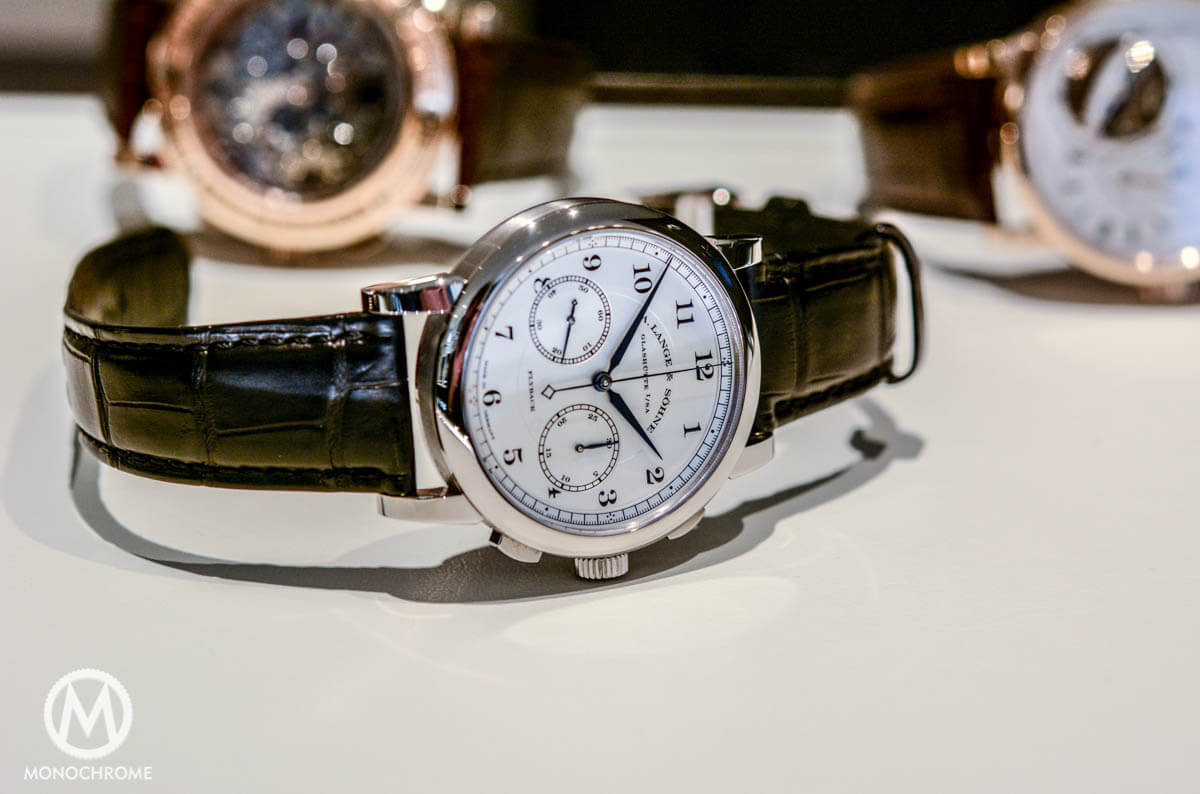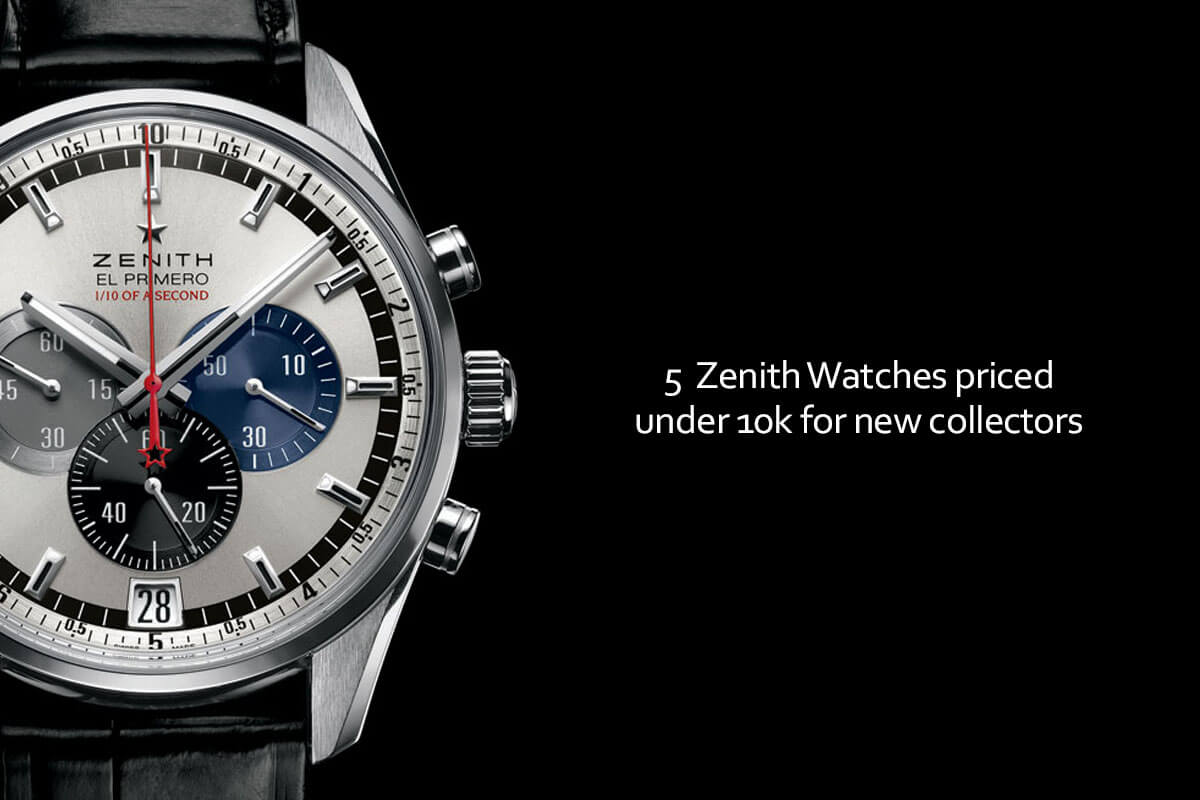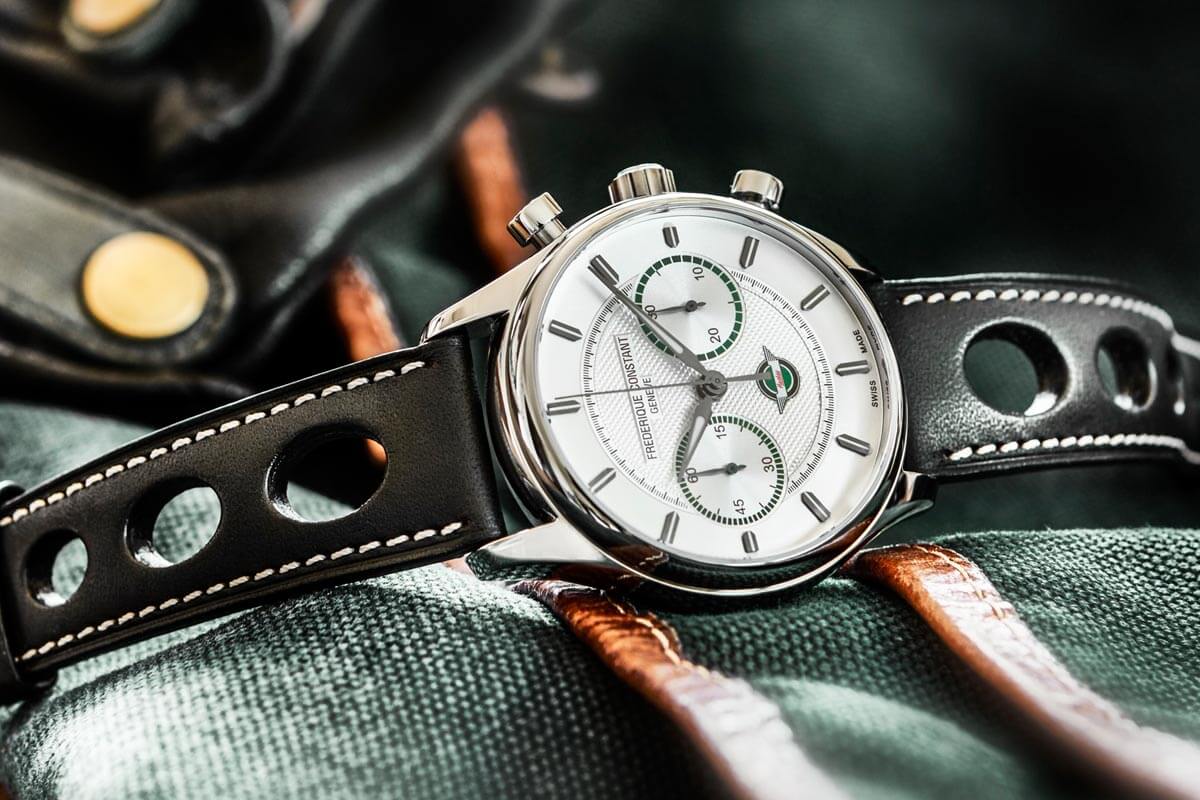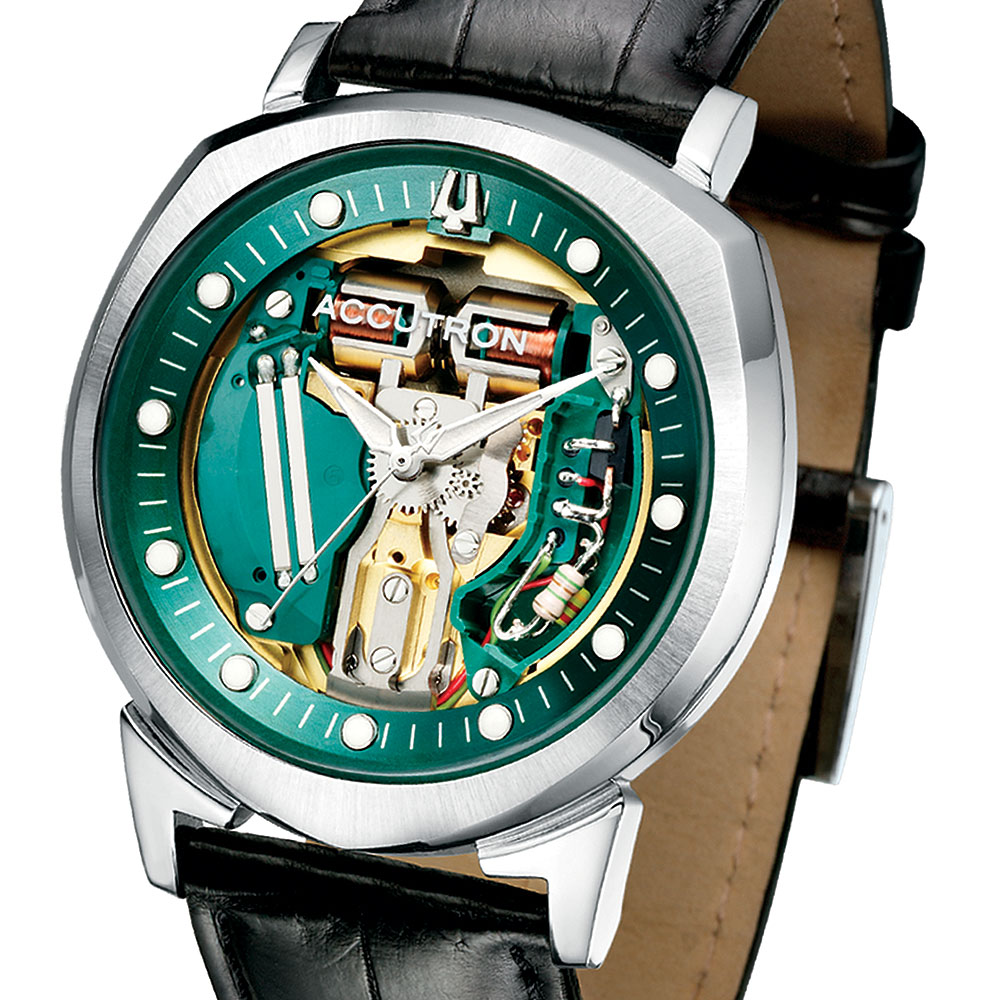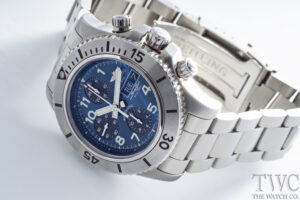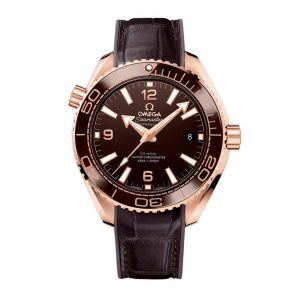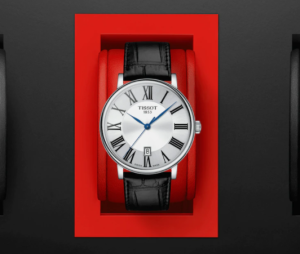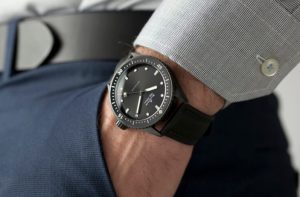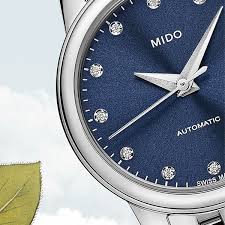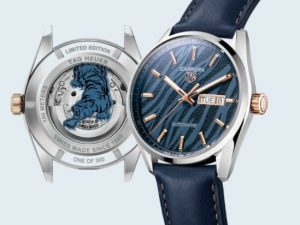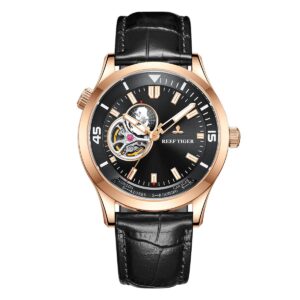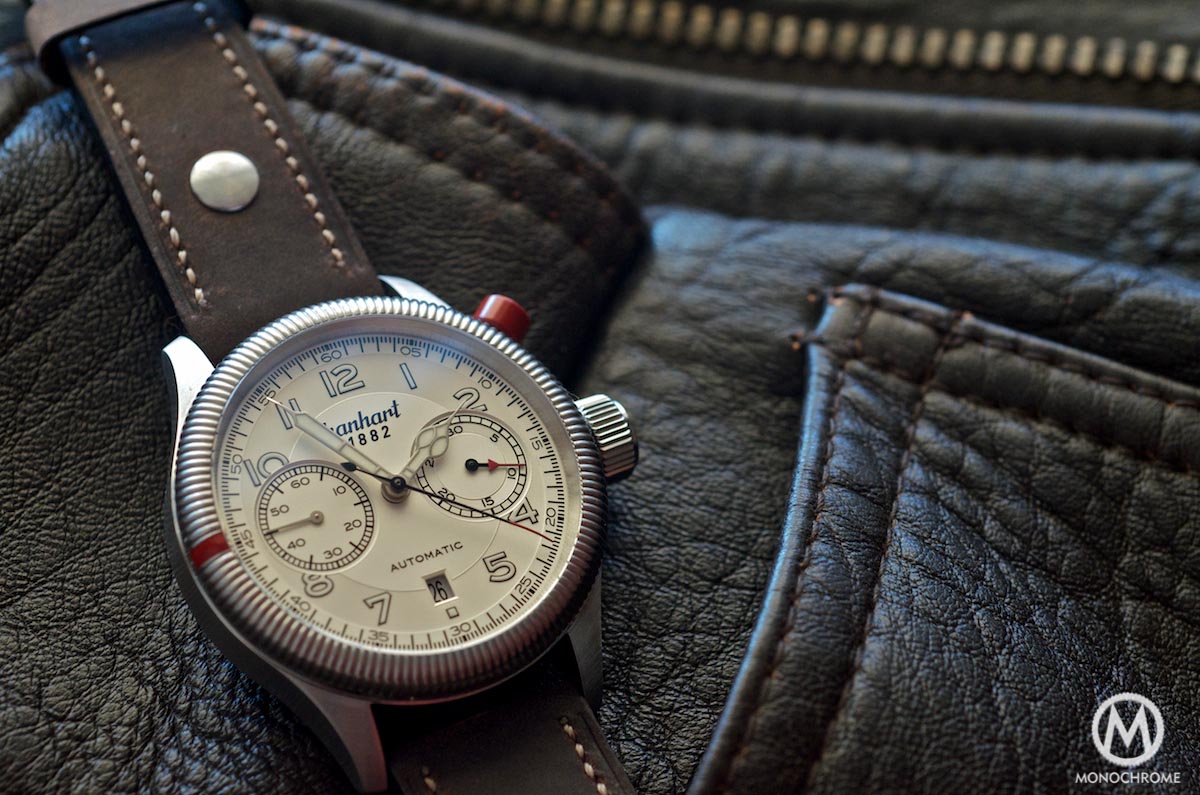
One of the most enduring traits in the watch industry in recent years is the New-retro design. This principle is the tendency to create something new that is not exactly new but rather follows the past. This industrial/marketing strategy balances in most cases innovation and tradition. The historical heritage of a product is fused with new materials and modern construction in order to create something desirable which possess a different aura, perhaps more refined and romantic. As everything in life, this strategy has its pros and cons while we can often witness companies trying to create a product of this kind out of thin air. In our case we will review a very important military chronograph with unmistakable originality. Almost every watch company today has an offering of a pilot’s chronograph. However, few designs have the pedigree of the one we will review. Hanhart is a company that still produces its iconic flieger chronographs with modern materials and calibres, thus potential buyers can enjoy a watch that can be worn every day, that is mechanically reliable while it boasts the aura of the first military flieger chronographs of the WWII. The Hanhart Pioneer Monocontrol is truly one of the archetypical military chronographs in the history of watches.
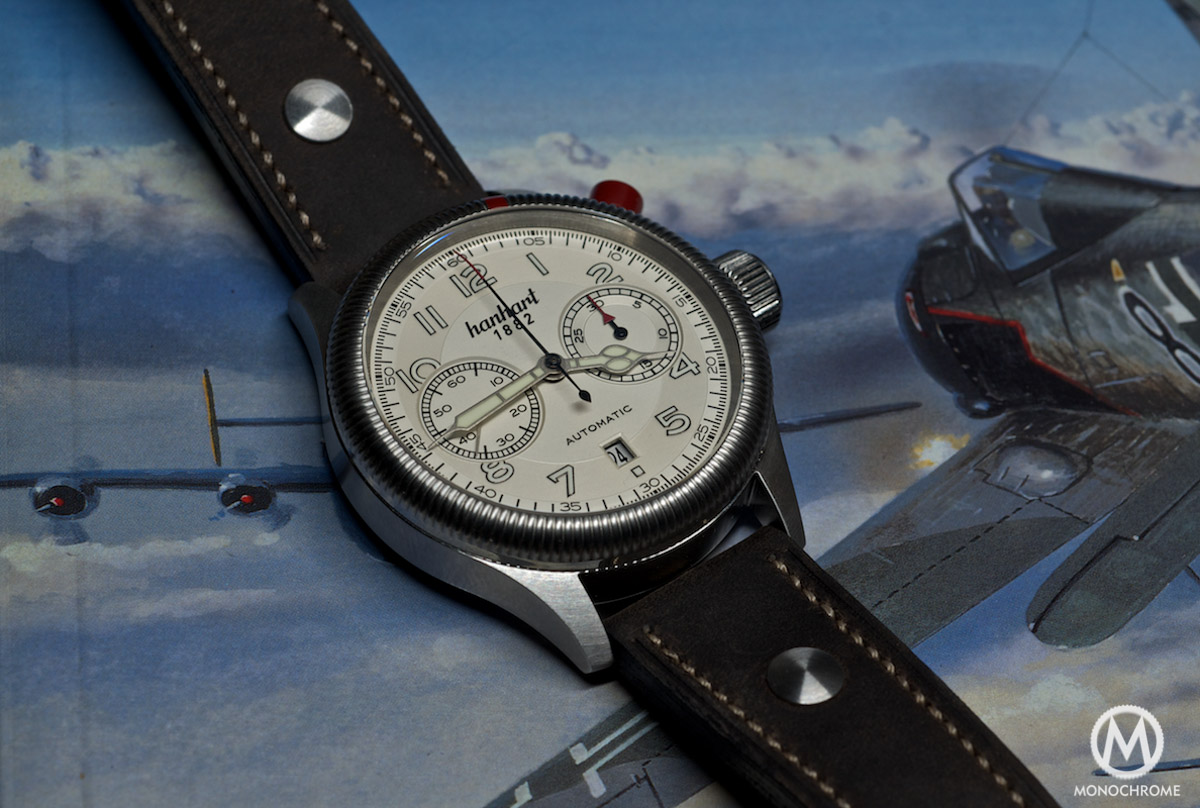
History of the Flieger-chronograph
First and foremost, we must answer what is the fundamental essence of a pilot’s chronograph and how it was used back then, on military fields and in the air. The first answer that comes to mind is that pilots needed a reliable timepiece to help them for navigational purposes either on Dead Reckoning navigation or by using radio “lighthouses”. During WWII, a compass and a watch in conjunction with flight charts and slide rules were the tools for the trade. A rather simplified way for the pilots back then was to use the formula “distance = speed x time”. If we took as granted that a pilot knew his airspeed he could use his accurate and reliable timepiece in order to check time therefore a Dead Reckoning position could be calculated and marked. From that point onward, the pilot could use the rotating bezel on its chronograph in order to mark a point in time where the last change in the aircraft’s heading was made.
Another situtation where the chronograph could be used to help navigation was by using radio “lighthouses” that send a signal at fixed intervals. Quite simply the operator could time the interval of any given signal in order to identify the beacon, and then he could mark the bearing of the beacon on his map and draw a line in order to find out the bearing from this exact beacon. Other ways also could be used such as the “cross-cut” method or the use of a “compass transmitter”. In all of these, a time measuring instrument was paramount. Aircraft had cockpit clocks therefore pilots could use these, however a reliable backup is never a luxury, and the tool wristwatch as we already foretold had its significance and could be used in life saving situations.
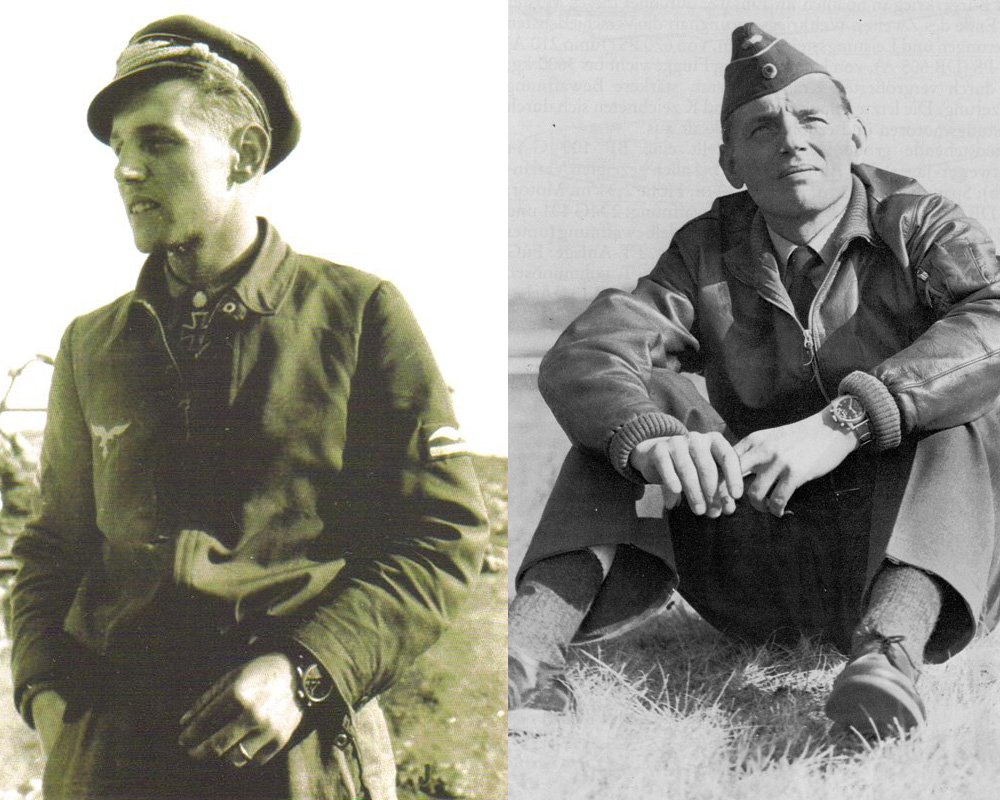
The Hanhart company was founded in 1882 in Diessenhofen, Switzerland by Johann Adolf Hanhart and in 1902 the factory moved to Schwenningen, Germany – considered then as the center of German clock manufacturing. Willy Hanhart, the son of the company’s founder, was instrumental for making the company famous. Up to that point, stopwatches came exclusively from Switzerland at outrageous prices. Thus, Willy Hanhart, irritated by this, decided to specialize. Hanhart became very well respected for producing some of the finest chronographs, wristwatches and professional gauges and instruments.
In 1938, the company revealed the single-pusher calibre.40 chronograph – this wristwatch is the forefather of the watch that we will review here. The famous calibre.41 and the Tachy Tele models followed the year after and from that point onward, Hanhart chronographs were used by Navy officers Stuka diver bomber and Jagdflieger pilots of the German Luftwaffe. The Luftwaffe Flieger-chronograph was produced by Hanhart and Tutima (that was then known as UROFA-UFAG). Hanhart was first in 1938 and Tutima followed in 1941. The design ethos of the watch created was an instant success and its use by the fighting pilots in those dark days of the WWII, in parallel with the features the chronograph incorporated, helped to create an iconic aviation timepiece.
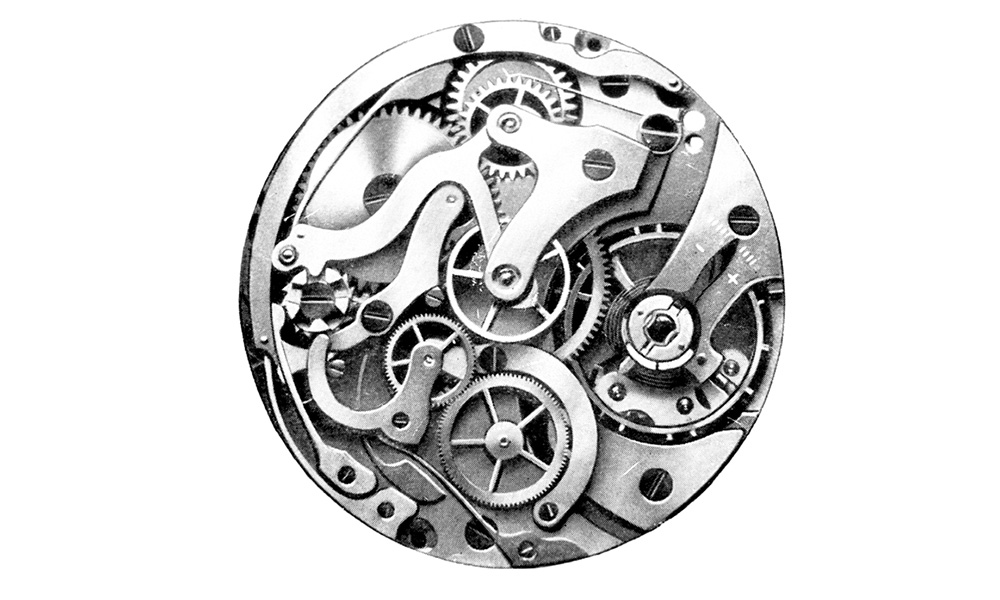
Hanhart produced two (plus one) versions. The single pusher calibre.40 and the double pusher flyback calibre.41 – and we also had the Tachy-Tele model, which incorporated red telemetric scales on the dial (used for naval Guns by the kriegsmarine). The calibre.40 was a manual wind chronograph with two subdials. The one at 9 o’ clock was the 60 seconds subdial and the one at 3 o’ clock the 30 minutes subdial. It was a single pusher calibre with a Breguet mainspring and a stem from a pocket watch. It had 17 jewels and beat at 18,000vph. The asymmetrical Double pusher Calibre.41 that followed in 1939 had a flyback complication – extremely useful for pilots, as seen with the Breguet Type XX.
These chronographs had several traits in common: black dials with Arabic numbers (enhancing high legibility and creating an uncluttered dial), a 30-minute counter, poire squellete hands, asymmetrical pusher buttons and also a rotating bezel (although versions without one existed). One unfortunate characteristic of these watches was their nickel-plated brass cases; good quality steel was needed elsewhere. Therefore, these original specimens can be found today in terrible condition. Another characteristic was the red colored chronograph button used, the distinctive trademark that has characterized Hanhart since the company first introduced its chronographs in 1938. The button was painted to prevent pilots from unintentionally zeroing the stop time. However, there is a legend behind this and as always there is a woman involved. According to the story a pilot had an affair (classic!!!) and after a romantic night:
He placed a kiss lovingly on her brow as she slept before quietly leaving the apartment. As he looked at his Hanhart watch in the hangar, a smile flitted over his lips: she had painted the button with her red nail varnish so that he would think of her always and return safe and sound …
After the war Hanhart continued to produce watches for the allies, especially the French armed forces, since the Black Forest region, where Hanhart were located, was part of the French Occupation Zone. As part of the German reparation payments to France, watches were produced by Hanhart under the Vixa (Type 20) name for the French military. In 1956/7 Hanhart were allowed to go back to making their own signed watches, and continued to make the Fliegerchronograph for the Luftwaffe & Kriegsmarine. Two variations produced, the 417E had a brass case and the -ES had a stainless steel case. The 417 as an issued chronograph was short lived, and in 1958 the Hanhart was replaced by the Junghans-J88 as BUND issued while later chronographs from Heuer, Orfina-PD, Tutima, Arctos and Tengler followed.

Here, we must mention two things. Firstly, Hanhart’s Fliegerchrono design was very influential since it created a specific design ethos that many manufacturers followed for their military and aviation chronographs. The Vixa and the creation of the classic Breguet Type 20 and also the transformation of the Breitling AVI (story Part 1 – Part 2 – Part 3) after the war is perhaps the most important element that proves that this aviation chrono design and configuration is one of the most iconic aviation chronographs ever. Secondly, the model 417 ES was the chronograph of choice of the King of Cool. The great Steve McQueen wore almost religiously a Hanhart chronograph. I rest my case!!!!
The Hanhart Pioneer Monocontrol
The Hanhart Pioneer Monocontrol is reminiscent of the 1938 calibre.40 model. Its case is slightly updated to 42mm while it has a 14,8mm height and 51mm lug-to-lug size; Last but not least the lug spacing is 21mm. The Hanhart Pioneer Monocontrol is very well balanced on the wrist and actually it wears smaller than its dimensions suggest. The design is very austere and the case is very nicely brushed with a huge signed crown which has a great feel and grip. Also on the outside there are two defining Hanhart features, the red single pusher and the fluted bezel.
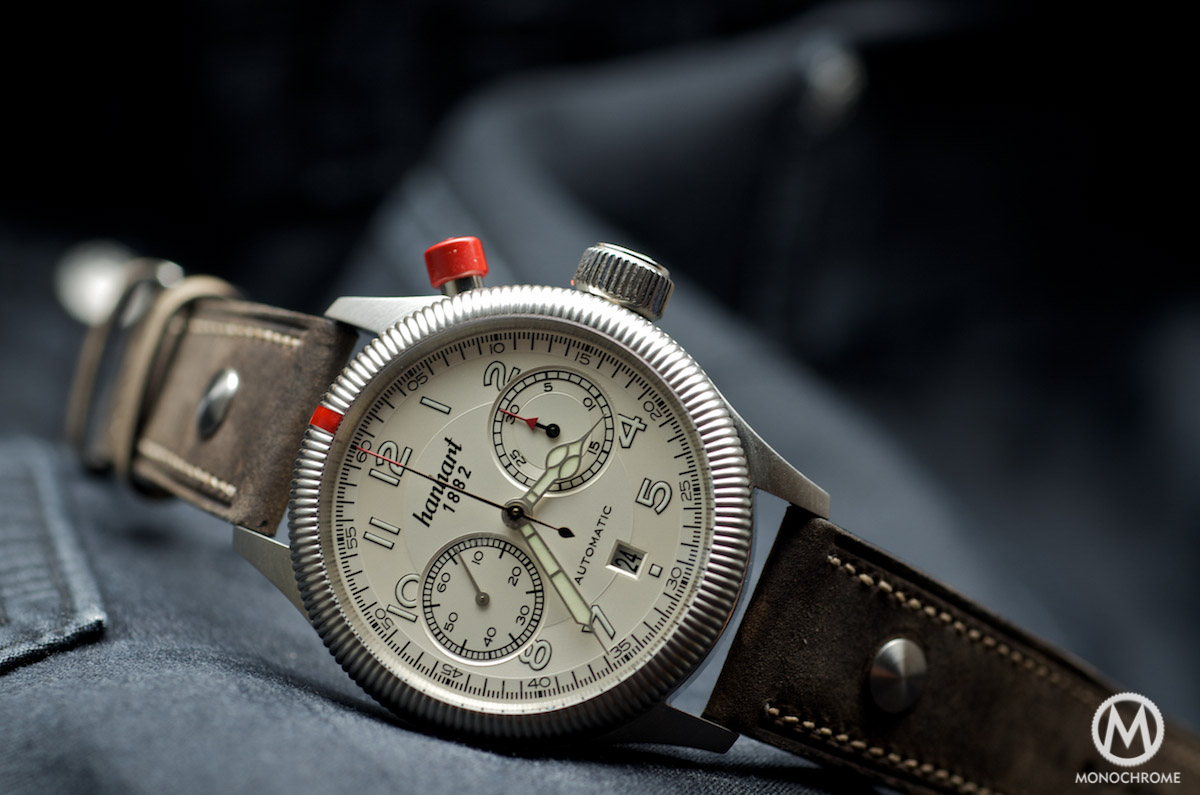
The second’s hand on the Hanhart Pioneer Monocontrol cannot be restarted since all chrono functions are performed by the only pusher button (Start-stop-zero). Someone might think that this is quite archaic but there is a logic behind this configuration. A one-button chrono is almost perfect for navigating and measuring distances while performing dead reckoning navigation over the sea ruling out any possibility of faulty navigation by dispensing with the need for an additional zero button. Cockpits back then were quite crammed and busy environments. The pusher also incorporates a red ceramic cap as a warning to pilots and if one looks closely, it is placed at a wider angle and quite close to the lug than Normally. This positioning gives the pusher more clearance and ergonomically, it helps a lot.
Hanhart, in order to be as original as possible, redesigned the calibre by placing a large shift lever responsible for the third strike on the chrono cam. The cam is also modified so that an additional tooth is placed on its lowest level, thus controlling not two but three functions. The fluted bezel is another characteristic of the Hanhart Pioneer Monocontrol. It is bi-directional and very easy to turn with a red origin point, which can be used in order to mark a specific time event – a visually pleasing and very functional detail which I found quite useful myself in my time with the watch. Last but not least the caseback is very much in line with the military / aviation character of the watch.
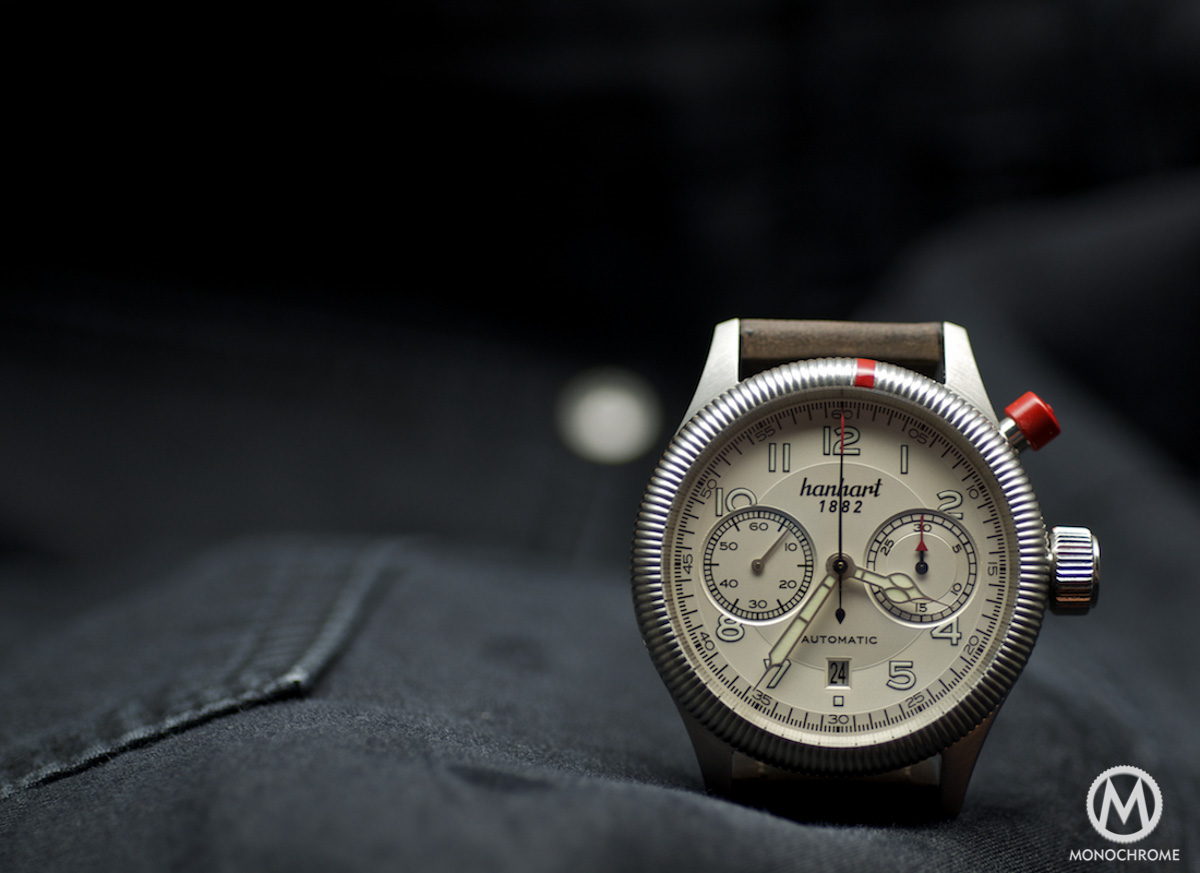
The dial follows the general design of its ancestors, however with elements that modernize it a lot. The bi-compax layout is perfectly balanced with various texturing and stamping. There are two choices, black and silver and while I much prefer a black dial, I was quite surprised by how silver reflects the light – which, in addition with the anti reflective sapphire crystal, creates a great viewing experience for the owner of the Hanhart Pioneer Monocontrol. The printing on the dial is quite superb with Arabic numerals filled with green Luminova material, which could be better in my view.
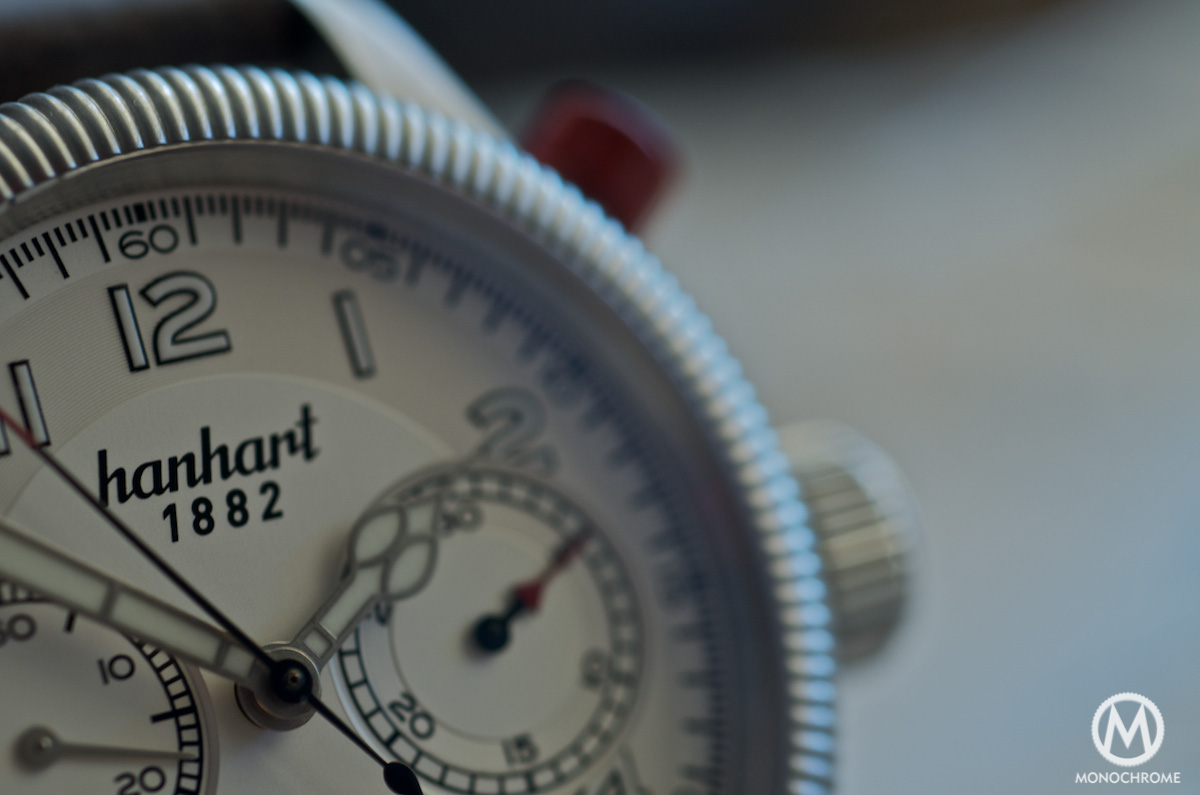
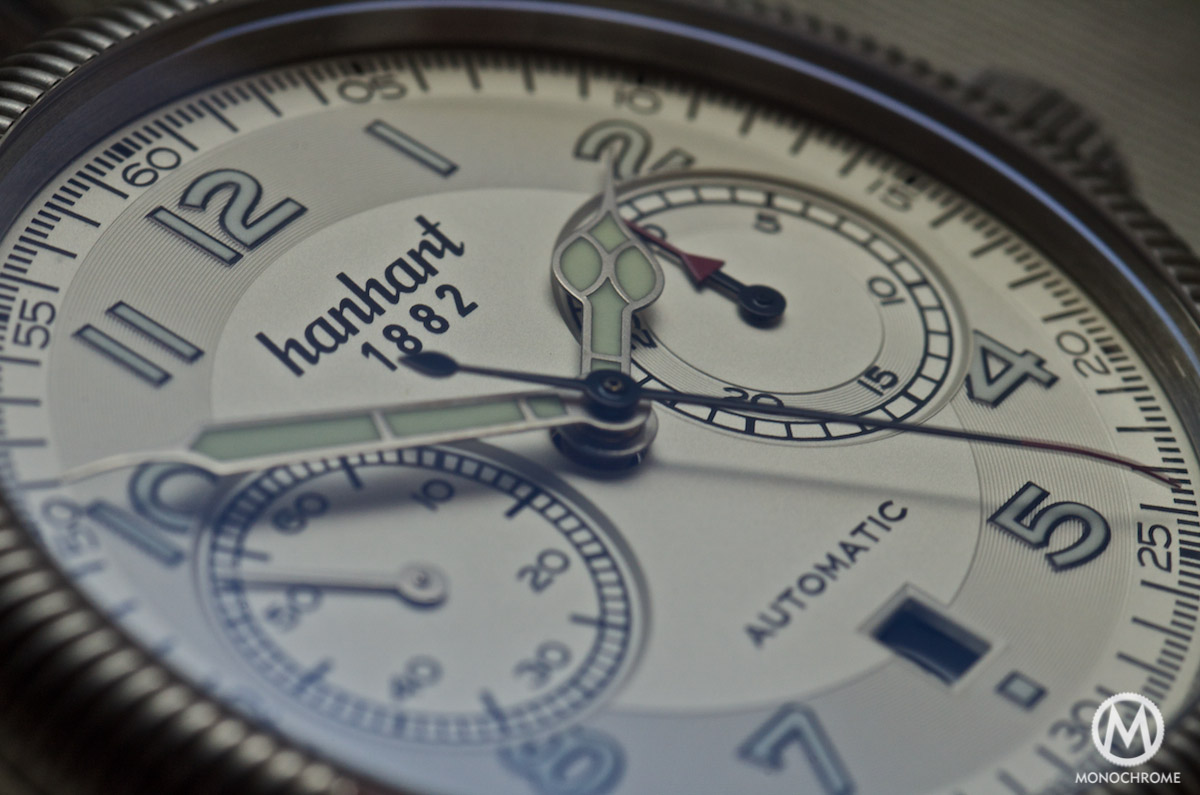
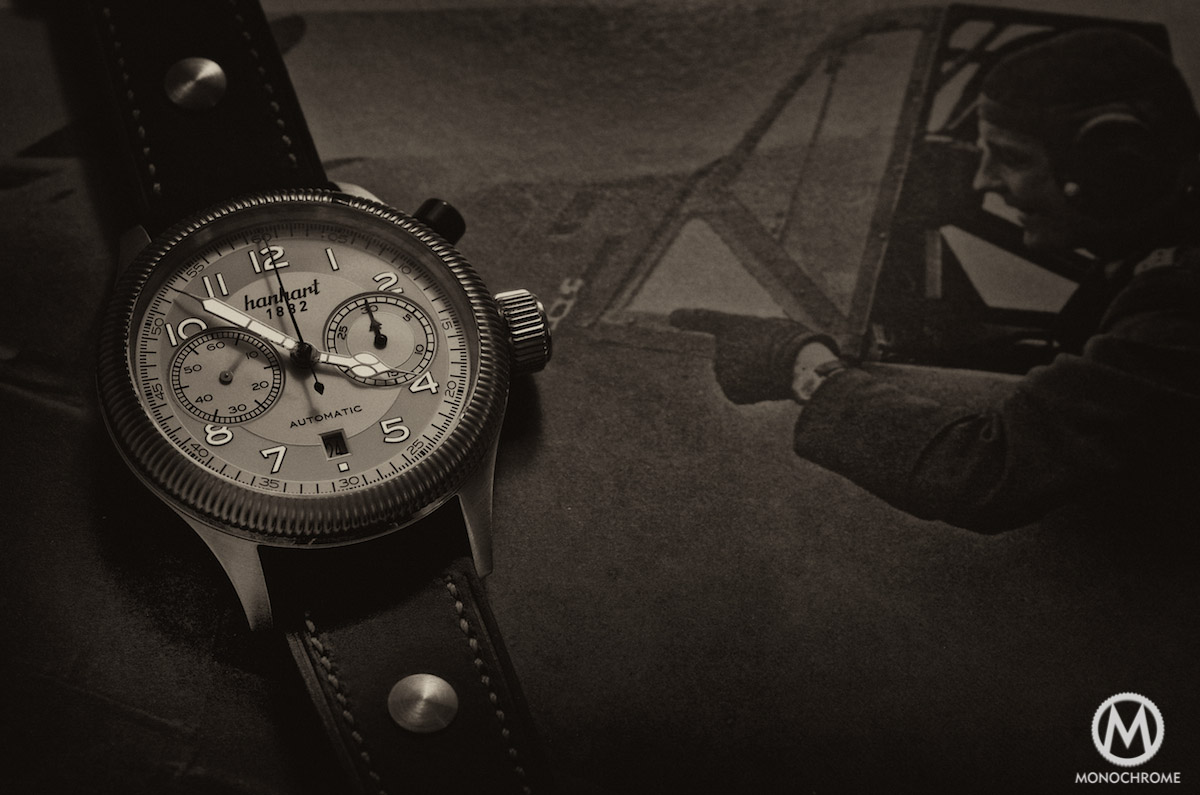
At 3 and 9 o’ clock we find the two sub-dials. The constant seconds dial is pretty plain with railroad index while the 30-minute sub-dial features a more complicated design, with a nicely red tip hand. The size and spacing of the sub-dials is ideal for the watch since they are very nicely proportioned. The dial is at the same time full of detail and very uncluttered. The hands of the Monocontrol are lumed (could also been much better) and pretty much refers to the original. At first glance they are very weird – skeleton hands are a thing of the past and they are out of fashion, however, after a while, my eyes get used to them and I stopped complaining. Now I think that Hanhart did right to keep them, since they help the Monocontrol to retain its original character. Last but not least, we find a date window at 6 o’ clock while the central seconds hand has a greatly executed red tip – a very nice detail in my opinion.
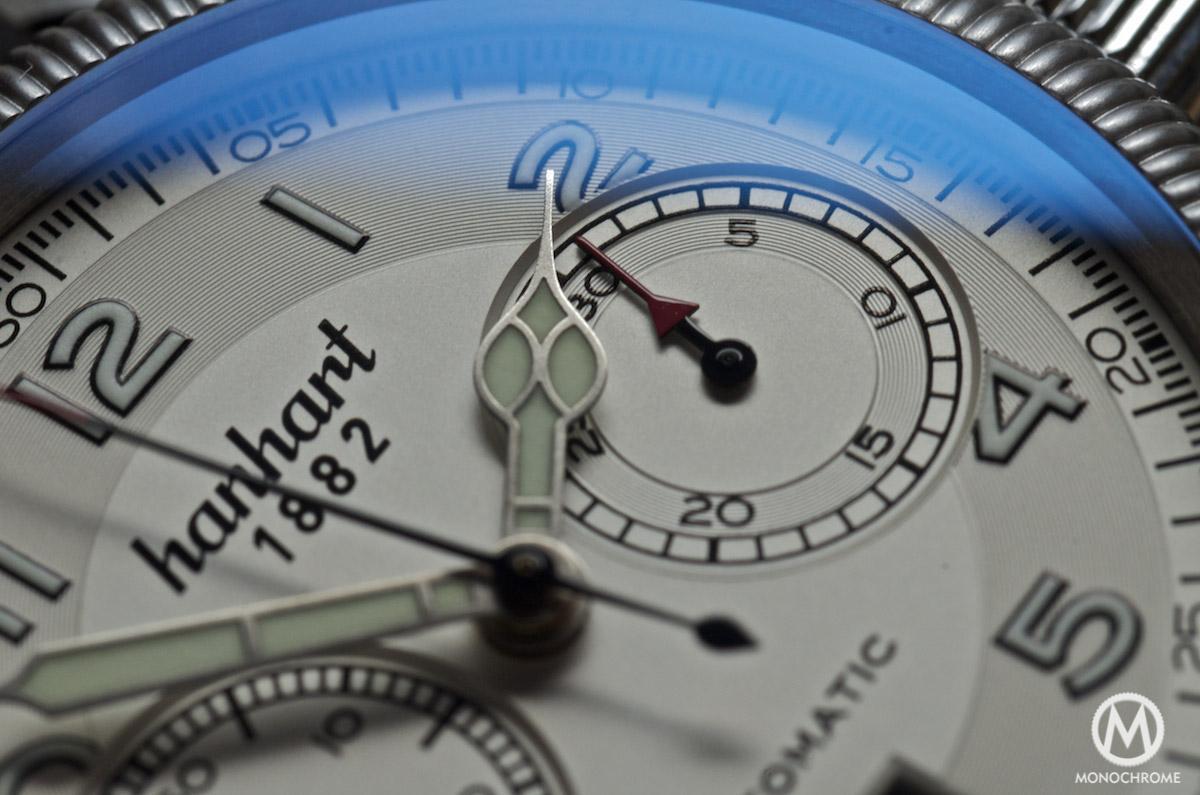
The Hanhart Pioneer Monocontrol features the HAN3911 calibre, which is actually a modified Valjoux/ETA 7750 calibre. It features 28 jewels and runs at 28,800vph, with a power reserve of 42 hours (all classical specifications for a 7750). The 7750 is very reliable and used by almost everyone in the industry. It keeps great time and it’s robust. Hanhart decorates the movement and rotor and modifies it in order to have a date wheel at 6 o’ clock, while the asymmetrical single-pusher button and its 3 way function (start-stop-zero) are also possible after extensive modification by the Hanhart technicians. What I find quite exciting is that for the price range of the Hanhart Pioneer Monocontrol, you purchase a great calibre, which you usually find in very high-end brands. A very unique calibre for a very unique watch.
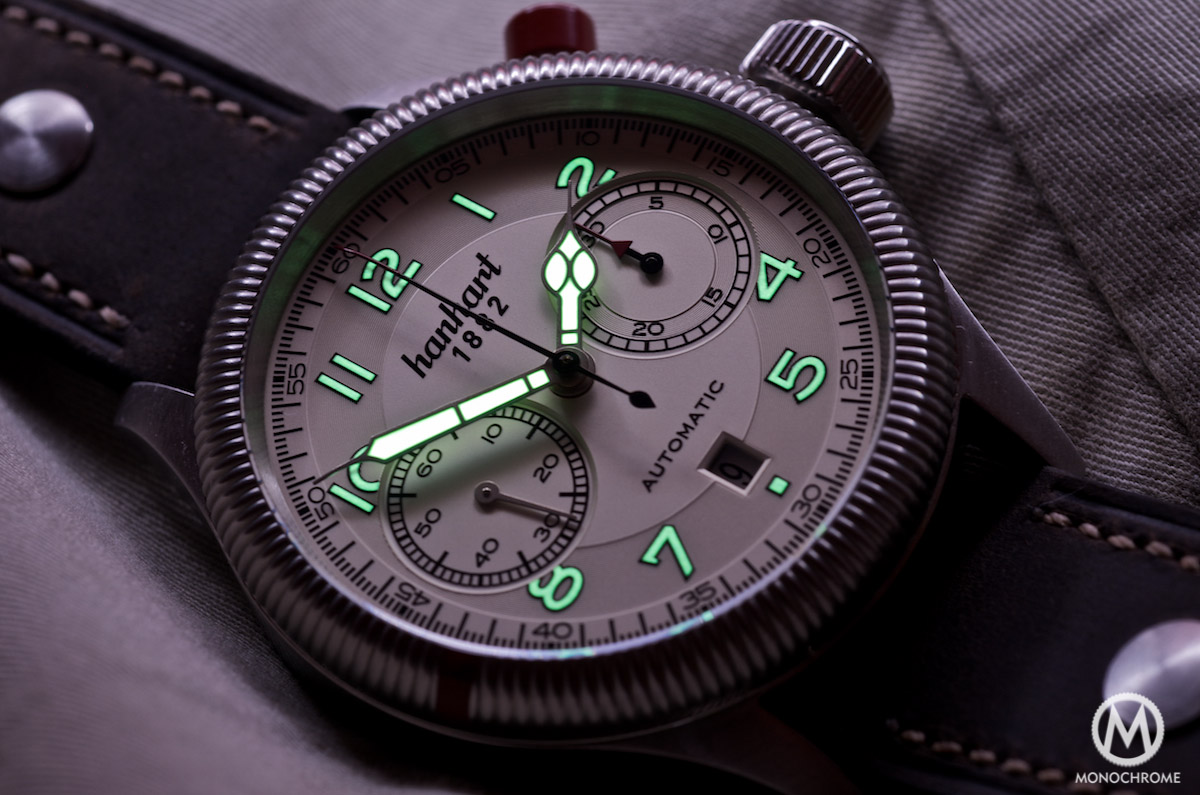
Last but not least, the watch came from the factory on a very nice rectangular black box that has a leather pouch with Hanhart stamping on it. Inside you can find the watch, secured by two button straps as well as the manual and a cleaning cloth. Overall I am quite impressed by the total package and the attention to detail, which you usually find on high-end brands, which of course retail for a much larger sum than the Monocontrol. The Hanhart Pioneer Monocontrol came with a very nice quality leather strap with a single rivet per side. The strap is comfortable despite its thickness and it felt like a custom made broken-in leather strap ordered from some obscure craftsman. Another good thing is that it slightly tapers towards the buckle and that helps the overall comfort in your wrist. The negative issue about the strap is that its 21mm in width. Finding third party straps might be a slightly difficult task. Price: 2,950 Euros.
Conclusion
Overall I am quite pleased by the Hanhart Pioneer Monocontrol. It is based on an archetypical military / aviation chronograph and pretty much achieves in retaining the character of its ancestors, embellished with modern elements that strike a very nice balance. The Monocontrol is at the same time pure aviation / military chronograph with luxury and sport elements. This Hanhart is a single pusher, something quite rare on the market (or at least usually much more expensive) and it also uses a highly-modified calibre. In my opinion, it creates an excellent watch, perfectly priced. The watch is comfortable on the wrist and visually pleasing. It has the right proportions, with a balanced dial, which is both uncluttered and highly detailed. Quality of construction is superb and the overall presentation package left me with very nice feelings.
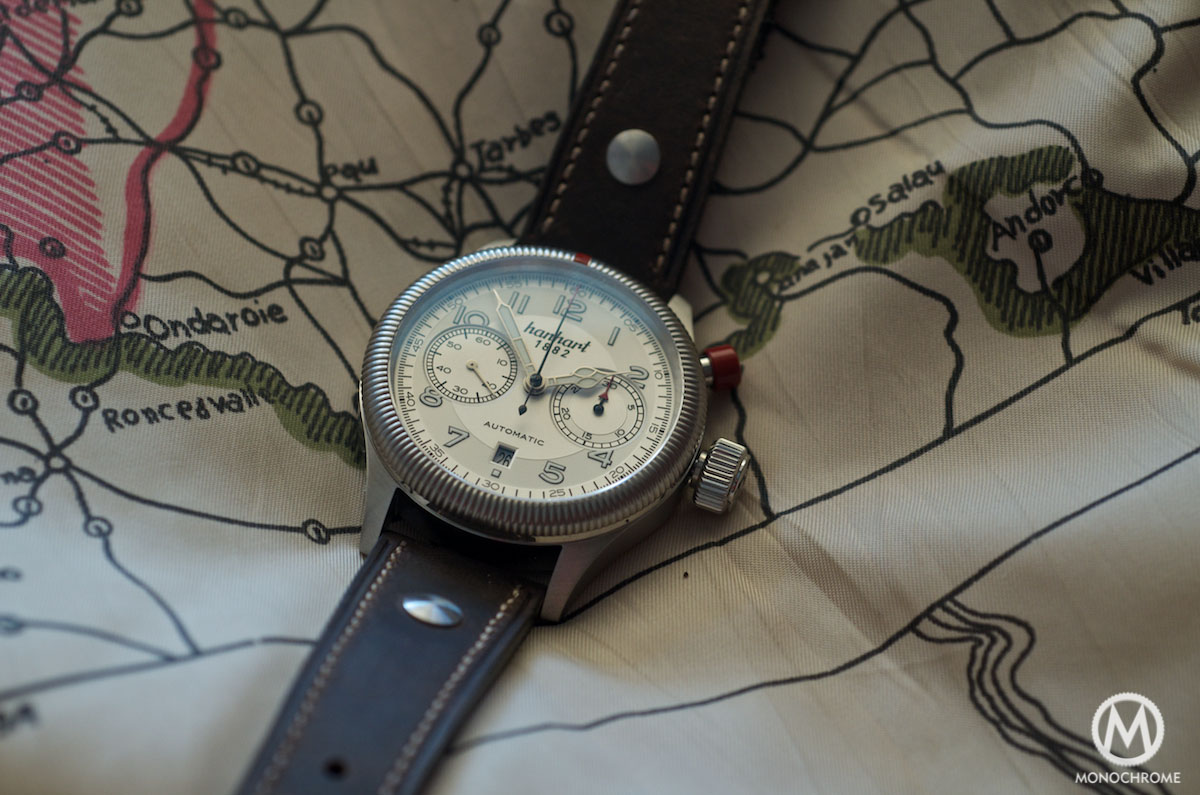
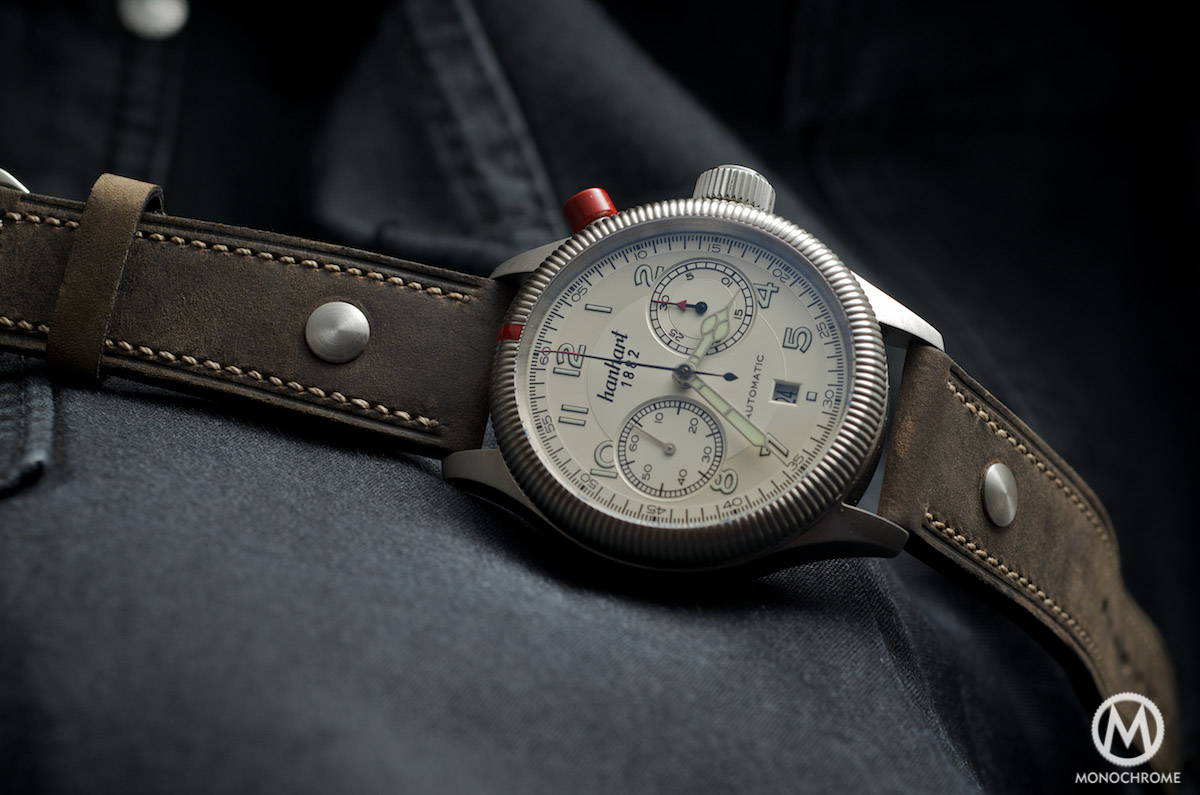
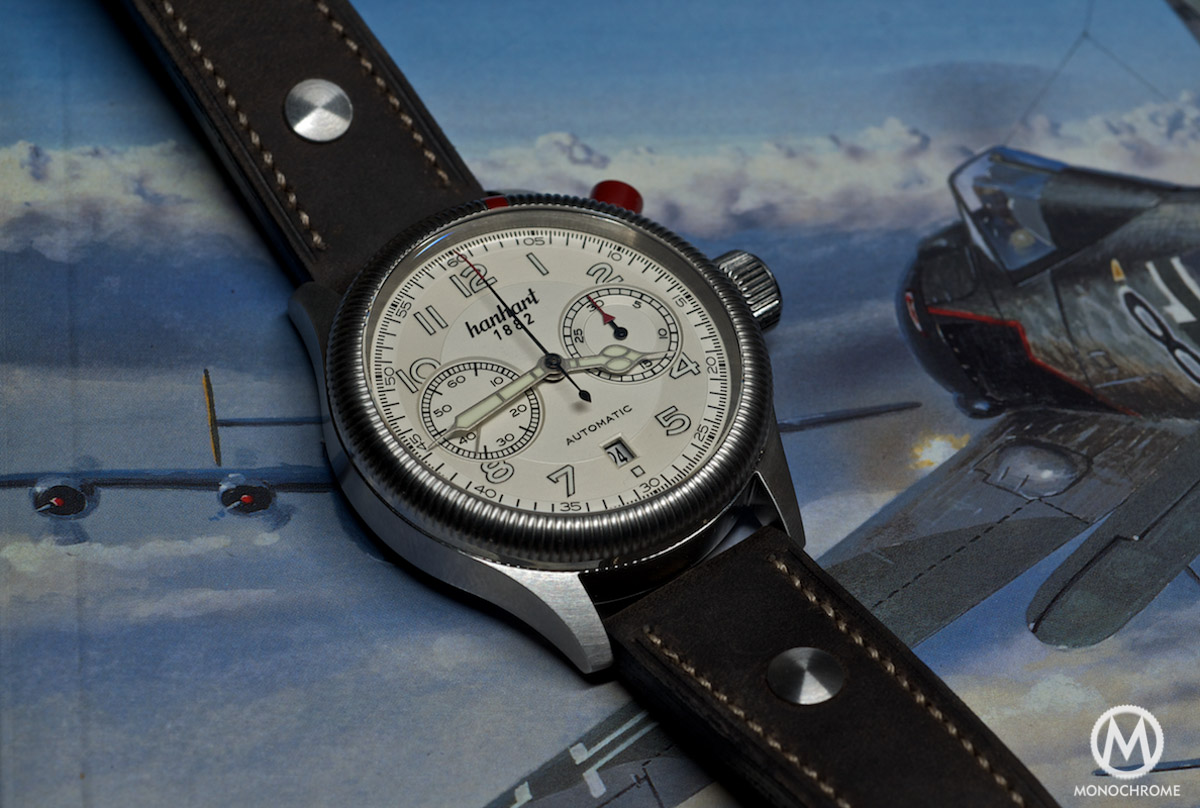
I can only spot two negative elements – and we’re talking about minor ones. I would prefer a more efficient luminous painting. Don’t get me wrong, the lume is very nice, however I would prefer it to better catch the light and to last longer. Also, the 21mm spacing between the lugs worries me a bit. This is not a big deal since the genuine strap is quite superb, but its good to have options and with this unusual lug-spacing, this could be a little tricky. On every other aspects, the Hanhart Pioneer Monocontrol passed the tests with honors.
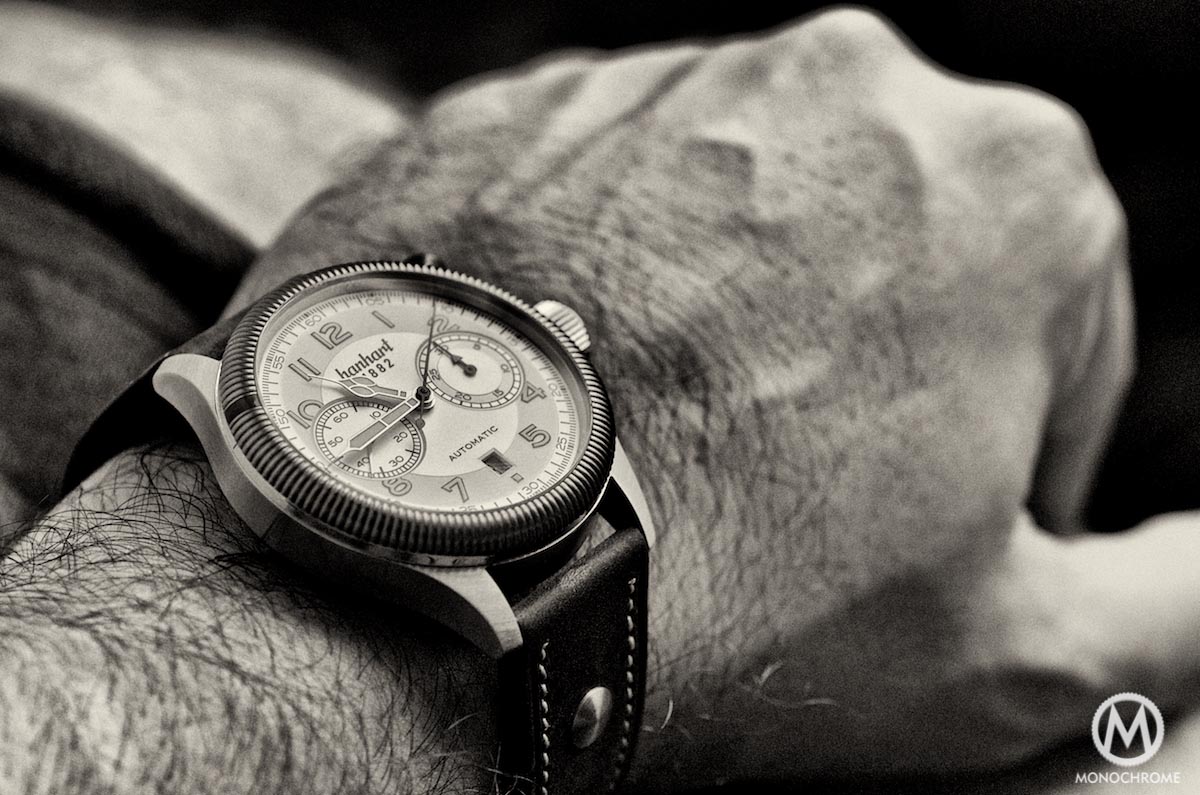
The Monocontrol is, for me, a blast from the past. It reminds us of the first days of aviation. It’s a tool watch from another era: it is functional, beautiful and very cool to wear. The mono-pusher feature is a magnet for discussions. Hanhart chronographs have been worn by some of the greatest fighter pilots ever (like the Top scoring ace of all time Erich Hartmann) and also by someone who’s probably the coolest guy ever, the King of Cool himself: Mr. Steve McQueen. In a market full of neo-retro watches, the Monocontrol boasts the original design from a truly iconic chronograph. Hanhart is a company that might not be the most known and covered of the market (in comparison with its Swiss rivals) but I think it deserves to be. The company has the pedigree and the know-how. Their military chronographs were historically important. With the creation of calibre.40 and 41, they created an iconic chronograph, which inspired many other brands. The Pioneer collection reflects all of these qualities and more – and I think that Hanhart chronographs are very, very cool watches… Damn, I want one!
Bibliography
- For a great presentation of vintage Hanhart watches and more info about the use of the watch check: http://www.watchprosite.com/page-wf.forumpost/pzt-/wf.responses_bLoB_s-/fi-17/pi-3206171/ti-527356/s-0/
- For an excellent write up about the relation of Hanhart and Steve McQueen check: https://heuerville.wordpress.com/2012/05/06/hanhart-417es-flyback-flieger-mcqueen/
- Check also another review by our own Max. E. Reddick here in Monochrome: http://monochrome-watches.com/hanhart-pioneer-mark-i-reviewed/
